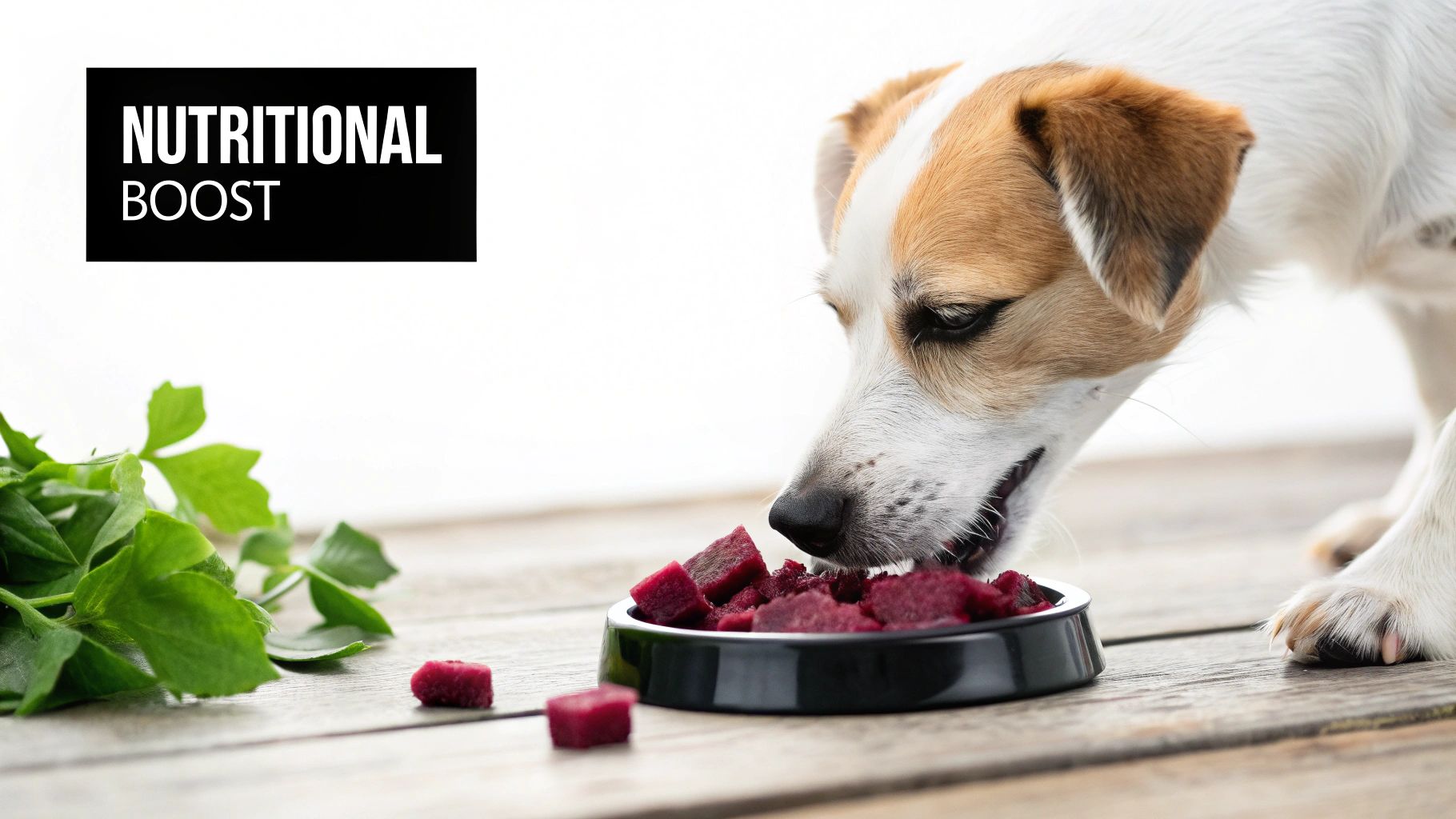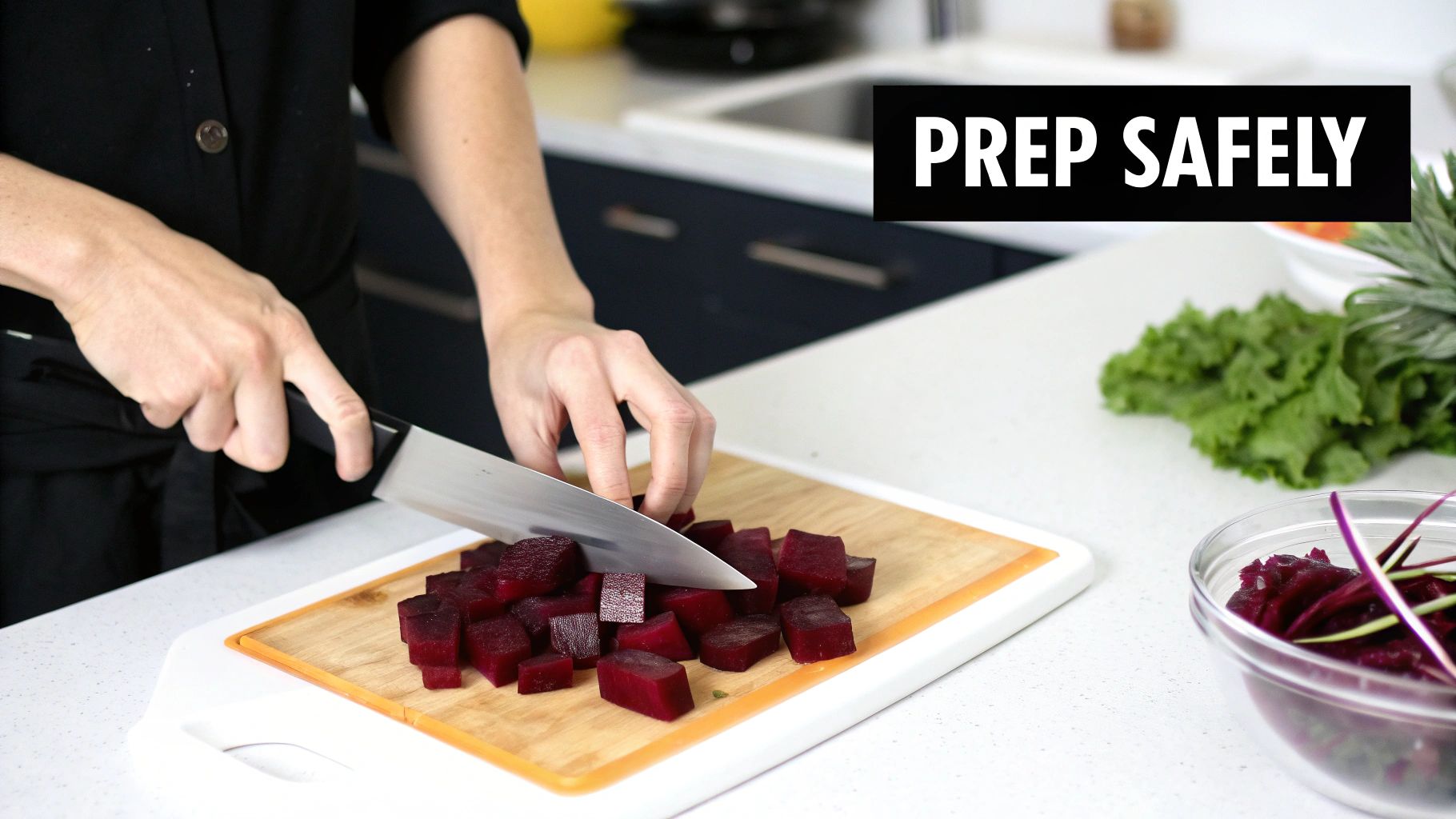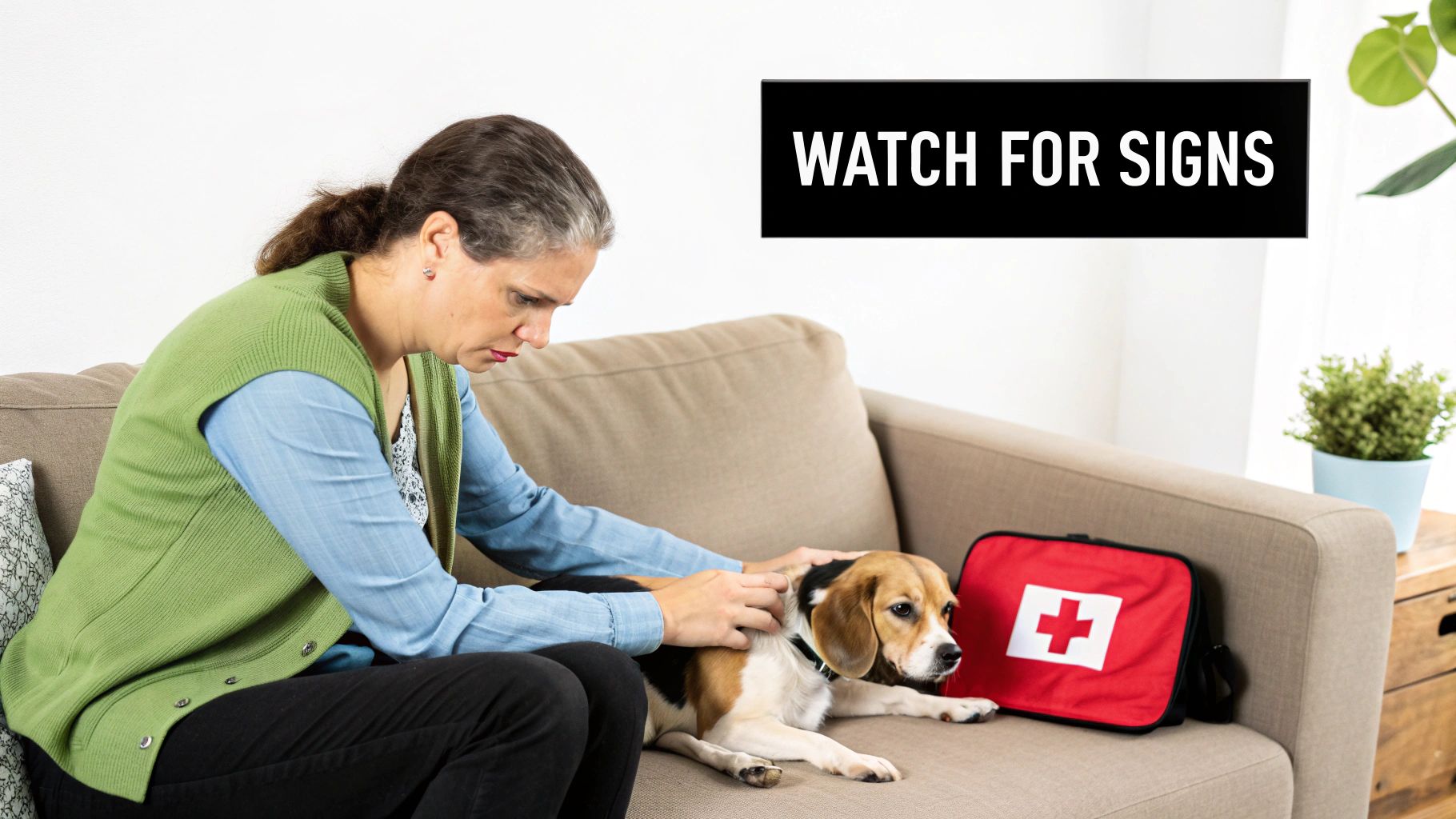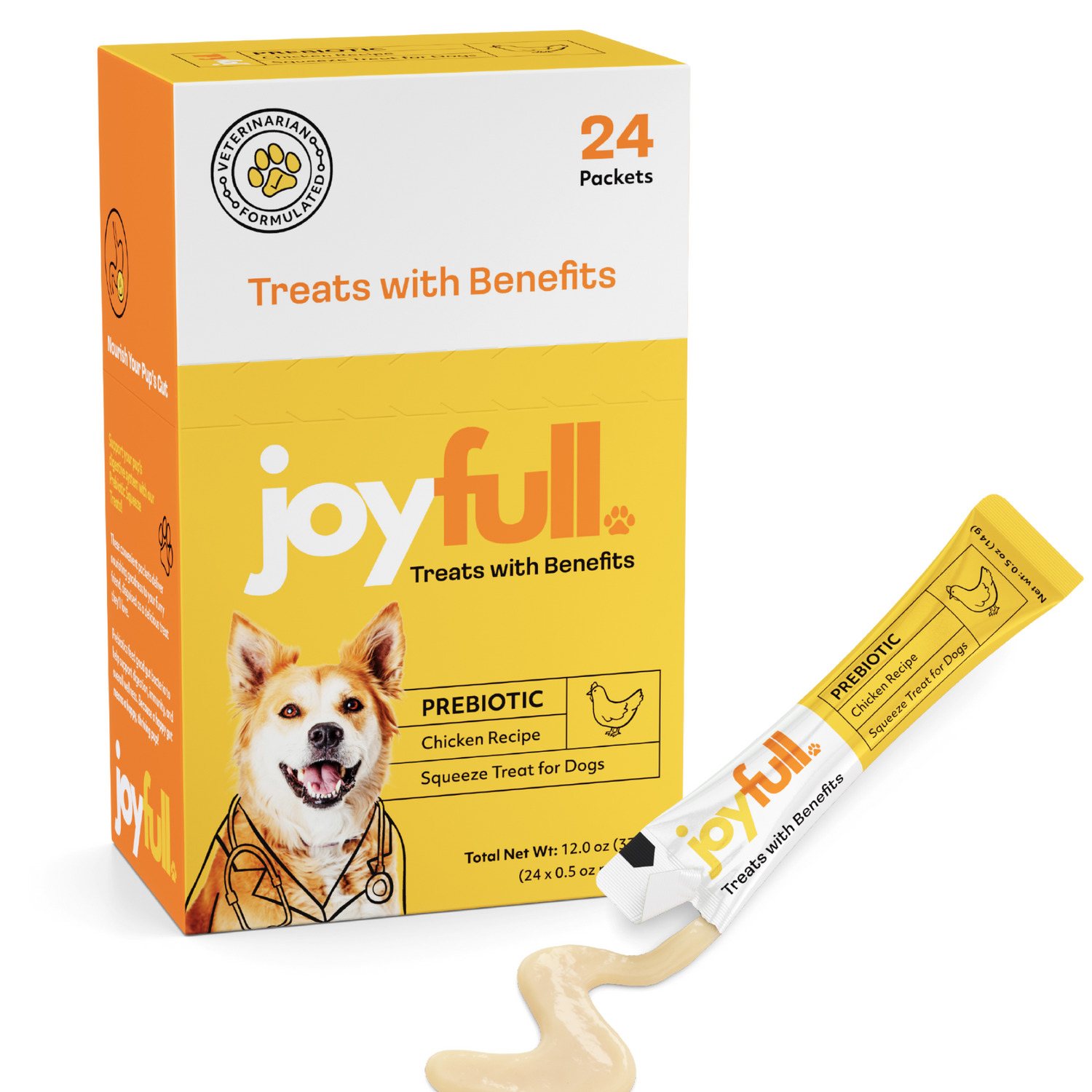
can dogs eat beets: Safe, Healthy Tips for Your Pup
So, you're eyeing that vibrant, earthy beet on your kitchen counter and wondering if you can share a slice with your furry friend. The short answer is yes, dogs can absolutely eat beets! But like most "people food," there are a few things you need to know to do it safely.
Think of beets as a special treat, not a meal replacement. They can be a fantastic, colorful, and healthy addition to your dog's diet, as long as they're prepared correctly and served in moderation.
The Simple Answer to Feeding Your Dog Beets

While the answer to "can dogs eat beets?" is a definite yes, how you serve them makes all the difference. This isn't a free-for-all veggie snack. The best and safest way to offer beets is cooked and completely plain. Introducing raw beets or beets with added seasonings can create problems you'd rather avoid.
It's become pretty common for owners to mix fresh veggies into their dogs' diets. In fact, a 2022 consumer survey revealed that 43% of dog owners give their pups vegetables as an occasional treat. Among that group, 28% mentioned beets specifically. The really telling part? A whopping 76% of those who serve beets make sure to cook them plain first to prevent any digestive issues. You can explore more of these pet owner trends to see how other owners are approaching it. It's clear that experienced owners understand that proper preparation is key.
Beets for Dogs A Quick Safety Guide
To cut through the confusion, I've put together a simple reference chart. This should help you quickly decide the best way to share this colorful veggie with your dog.
| Beet Form | Is It Safe? | Key Considerations |
|---|---|---|
| Cooked & Plain | ✅ Yes | This is the safest bet. Just steam or boil them until soft. |
| Raw Beets | ⚠️ With Caution | Can be a choking hazard and are tougher for dogs to digest. |
| Beet Greens | ✅ Yes | Offer them cooked and chopped, but only in small amounts. |
| Canned Beets | ❌ No | Usually packed with way too much added salt. |
| Pickled Beets | ❌ No | Made with vinegar, sugar, and spices that are bad for dogs. |
The takeaway here is simple: preparation is everything. If you stick with cooked, unseasoned beets, you can give your dog a nutritious and interesting treat without any of the worry.
Exploring the Health Benefits of Beets for Dogs

Beets are more than just a colorful addition to your dog's food bowl. When served the right way, this vibrant root vegetable is a genuine powerhouse of nutrients that can give your dog's health a real boost. Think of them as a small, all-natural multivitamin that complements their regular diet.
One of the biggest wins with beets is their high dietary fiber content. Fiber is fantastic for a dog's digestive system, acting like a traffic controller to keep everything moving along smoothly. This helps prevent constipation and promotes regular, healthy bowel movements—a cornerstone of great gut health.
Vitamins and Minerals That Matter
Beyond just fiber, beets are packed with a whole team of essential micronutrients. While they're no substitute for a complete and balanced diet, they can definitely fill in some nutritional gaps. Each vitamin and mineral plays a specific role in keeping your dog happy and active.
Here’s a quick look at some of the key players inside a beet and what they do for your pup:
- Vitamin C: A fantastic antioxidant that helps strengthen the immune system, acting as a little shield against illness.
- Potassium: This essential mineral is crucial for healthy muscle function—including that all-important heart muscle—and helps with nerve signaling.
- Folate (Vitamin B9): Absolutely vital for cell growth and making red blood cells, which carry oxygen all around your dog's body.
- Manganese: A key ingredient for strong bone development and healthy joints, manganese also helps the body absorb other nutrients more effectively.
All these nutrients work together, creating a team effort to support your dog's health. It’s always good to have a few safe veggie options in your toolkit. If you’re curious how beets stack up against other favorites, you can check out our guide on whether dogs can eat pumpkin.
Supporting Digestion and Coat Health
The one-two punch of fiber and water in beets is especially great for your dog's digestion. When their digestive system is working well, they can absorb more nutrients from their food, which has a direct impact on everything from their energy levels to the shine of their coat. A healthy gut often shows on the outside!
Beets can be a fantastic, low-calorie way to add beneficial nutrients to your dog's diet. Their unique combination of fiber, vitamins, and minerals supports everything from their digestive tract to their immune response.
So, when you ask, "can dogs eat beets?" the answer is tied to these impressive health benefits. A small amount of this root veggie can provide a meaningful nutritional lift, helping your best friend feel great from the inside out. Just remember the golden rules: start slow and always serve in moderation.
Getting to Know the Potential Risks for Your Dog
While beets pack a nice nutritional punch, it's just as important to understand the other side of the coin before you start slicing them up for your dog. Having a balanced view is what being a great pet owner is all about. For most dogs, these risks are pretty low when beets are an occasional treat, but knowing what to look for helps you make the best call for your furry companion.
There are three main things to keep in mind when it comes to beets: their natural sugar, compounds called oxalates, and the classic risk of an upset stomach. None of these are deal-breakers for every dog, but they’re definitely factors to weigh.
The Deal with Natural Sugars
Beets are sweeter than a lot of other veggies. It’s a natural sweetness, kind of like what you find in fruit, but at the end of the day, sugar is still sugar. For a healthy, active pup, a little bit of this sugar is no big deal.
But for dogs with specific health issues, it's a different story. If your dog has diabetes or is struggling with their weight, the sugar in beets can cause their blood glucose to spike. That’s something you definitely want to manage carefully. For these dogs, it's a smart move to chat with your vet before making beets a regular goodie.
A Closer Look at Oxalates
Beets contain naturally occurring compounds called oxalates. Inside the body, these can link up with calcium and sometimes form tiny crystals. For the vast majority of dogs, this isn't an issue at all—their bodies just flush the crystals out in their urine.
The concern is for dogs that are genetically prone to developing kidney or bladder stones, especially calcium oxalate stones. In these pups, a diet that’s heavy in oxalates can unfortunately raise the risk of forming these painful stones.
If your dog has a history of urinary tract problems or is a breed known for bladder stones (like Miniature Schnauzers, Lhasa Apsos, or Bichon Frises), it’s best to play it safe and skip the beets.
The Classic Tummy Ache Risk
Finally, just like any new food you introduce, there’s always a chance of digestive upset. Beets are high in fiber, which is great in moderation, but too much all at once can be a shock to a dog’s system.
This can lead to some not-so-fun symptoms:
- Gas and bloating
- Diarrhea
- Vomiting
- General stomach discomfort
These signs are basically your dog’s way of saying, "Whoa, that was a bit much!" It’s usually not an allergy, but it’s still good to know the difference. You can learn more about what causes food allergies in dogs to get a clearer picture. The golden rule is simple: start small and keep an eye out for how your dog handles it.
How to Prepare Beets for Your Dog Safely

Alright, you know the pros and cons of beets. Now for the most important part: how to actually get this veggie into your dog's bowl safely. The answer to "can dogs eat beets?" really comes down to how you prepare them.
Think of it this way: plain, cooked beets are a healthy treat. But beets that are raw or loaded with seasonings? That's where you can run into trouble.
The golden rule here is to keep it simple. If you can, grab some fresh, organic beets to keep pesticide exposure to a minimum. Before you do anything else, give them a really good scrub under cool running water to get rid of any lingering dirt.
Choosing the Best Cooking Method
First things first, cooking is a must. Raw beets are tough, making them a serious choking hazard, not to mention a nightmare for your dog's digestive system to handle. Cooking softens them right up, making them easy to chew and digest.
So, what's the best way to cook them for your pup?
- Steaming: This is probably my top pick because it holds onto the most nutrients. Just steam cubed or sliced beets until a fork pokes through them easily.
- Boiling: Another fantastic option. Boiling beets until they're soft is simple and gets the job done perfectly. Just be sure to drain them well and let them cool down.
- Roasting: You can absolutely roast beets, but you have to do it without any oil, salt, or other seasonings. I find wrapping them in a bit of foil and baking until tender works great.
No matter which method you pick, the goal is always the same: cook them until they are soft. And I can't stress this enough—serve them completely plain. No salt, no butter, and definitely no garlic or onion powder. Those things are toxic to dogs and have no place in their food bowl.
To help you decide, here’s a quick breakdown of the best preparation methods.
Beet Preparation Methods for Dogs
This table compares different ways to prepare beets, highlighting the safety and benefits of each method for dogs.
| Preparation Method | Safety Level | Best For | Preparation Notes |
|---|---|---|---|
| Steamed | Very High | Nutrient retention and easy digestion. | Steam until fork-tender. This is the best way to preserve vitamins and minerals. |
| Boiled | Very High | Simplicity and ensuring softness. | Boil until soft. Good for dogs with sensitive stomachs. |
| Roasted | High | Bringing out natural sweetness. | Roast plain with no oil or seasonings. Ensure they are fully cooked and soft. |
| Dehydrated | Moderate | Creating chewy, jerky-like treats. | Slice thinly and dehydrate until chewy, not brittle. Must be plain. |
| Raw | Low | Not Recommended. | Raw beets are a choking hazard and difficult to digest. Avoid this method. |
| Canned/Pickled | Very Low | Not Recommended. | High in sodium, sugar, and preservatives that are harmful to dogs. |
As you can see, simple cooking methods are always the safest bet for your dog.
Serving Sizes and the 10 Percent Rule
When it comes to treats, moderation is key. Beets should be a fun snack, not a meal replacement. The best guideline to follow is the 10% rule: treats shouldn't make up more than 10% of your dog's total daily calories.
For most dogs, this translates to just a few small, bite-sized pieces of cooked beet a couple of times a week. That’s plenty.
Always cut cooked beets into small, manageable cubes or pieces that are appropriate for your dog’s size. It’s a simple step that helps prevent choking and makes the treat much easier for them to enjoy.
Interestingly, you've probably seen "beet pulp" on a dog food label before. It's a byproduct of sugar beet processing and has been used for years as a great source of fiber. A 2018 study even found that beet pulp improved stool quality in 78% of dogs and was well-tolerated, showcasing its digestive benefits.
When you first introduce beets, start small. Give your dog just one tiny piece and keep an eye on them for the next 24 hours. If there are no signs of an upset stomach, you can offer a little more next time.
For some creative ideas on how to mix beets and other healthy ingredients into your dog's snacks, take a look at these healthy dog treat recipes. By sticking to these simple prep and portion rules, you can share the goodness of beets with your best friend without any worry.
Signs of a Bad Reaction to Watch For

Anytime you add a new food to your dog's menu, you have to play detective. Even safe foods like beets can cause a little trouble for some pups, so it's all about watching how their body responds.
Most dogs will handle a small taste of cooked beet without any drama. Still, it pays to know the warning signs, just in case. The first 24 hours after they try it are the most telling.
Think of it this way: beets are packed with fiber. While that's great in small amounts, too much at once can be a shock to a dog's digestive system. This usually leads to some pretty clear, if unpleasant, signs that they've had more than their tummy can handle.
Common Signs of Digestive Upset
If beets and your dog aren't a good match, their gut will likely be the first to complain. These signs tend to show up within a few hours and are a definite signal to back off the beets and let their system calm down.
Keep an eye out for these classic symptoms:
- Vomiting or Diarrhea: These are the most direct signs that something has disagreed with them.
- Excessive Gas: We're not talking about a single polite poof. If your dog is suddenly gassy and uncomfortable, their digestion is working overtime.
- Lethargy or Discomfort: A sore stomach can make anyone feel miserable. If your usually playful dog is moping, hunching over, or just seems "off," it could be a sign of tummy pain.
Beyond an upset stomach, a true food sensitivity might show up on their skin. Look for a sudden increase in scratching, obsessive paw licking, or red, irritated patches. If you spot any of this, it's time to take beets off the menu for good.
You might see something alarming in their potty area: red-tinted urine or poop. This is a harmless and common side effect called beeturia. It’s just the vibrant beet pigment passing through and is nothing to worry about!
When to Call Your Veterinarian
So, you see red poop—that’s one thing. But other symptoms need a more watchful eye. A bit of mild gas or a single soft stool probably just means you offered too much, too soon. In that case, simply stop the beets and keep an eye on them.
However, some situations are more serious. If your dog has persistent vomiting or diarrhea, seems extremely lethargic, or is showing clear signs of abdominal pain, don't wait. It's time to call your vet.
At the end of the day, you know your dog best. If your gut tells you something is genuinely wrong, a quick call to the vet is always the smartest move.
Got Questions About Beets? We've Got Answers
When you're trying to do right by your dog, it's natural to have a lot of questions. Even when you know the basics, certain situations can leave you guessing. So, let's clear up some of the most common things dog owners ask when they're thinking about adding a little beet to their pup's diet.
This is your go-to guide for those specific "what if" scenarios. We'll cover everything from the beet products to avoid to some... colorful side effects you might notice.
Can My Dog Eat Canned or Pickled Beets?
That’s an easy one: no. Stick to fresh beets you prepare yourself. While super convenient for us, the canned and pickled versions you find on grocery store shelves are loaded with ingredients that are bad news for dogs.
Canned beets are usually swimming in a saltwater solution. A dog’s body just isn't built to process that much sodium, which can lead to serious issues like dehydration, high blood pressure, or even sodium ion poisoning.
Pickled beets are a whole other level of trouble. They're soaked in a brine that's a cocktail of things your dog should never have:
- Vinegar: It’s far too acidic and can easily cause an upset stomach.
- Sugar and Salt: These are just empty, unhealthy calories for a dog.
- Spices: The pickling blend often includes things like onions or garlic, which are toxic to dogs.
To keep your dog safe, just walk right past the canned and pickled options. The best and only choice is fresh beets, cooked plain. That way, you know exactly what your dog is eating.
Are Beet Greens Safe for My Dog?
Yes, the leafy tops of the beet plant are perfectly safe for most dogs, but only in small amounts. They're actually packed with nutrients like vitamins A and K.
The catch? Just like the root, beet greens contain oxalates. This means you should only offer them as a tiny, occasional treat. If your dog has ever had kidney or bladder stones, it's probably best to skip the greens altogether to be on the safe side.
If you do serve them, wash the leaves thoroughly to get rid of any lingering dirt or pesticides. The best way to prepare them is to give them a light steam with no seasoning, chop them up into tiny pieces, and mix a small spoonful into your dog’s food.
How Much Beet Can I Give My Dog?
This is the golden question, and the answer is always moderation. Think of beets as a special treat, not a meal replacement or even a daily supplement.
A great rule of thumb for any treat is the 10% rule. This is a well-known guideline in the dog world that says treats shouldn't make up more than 10% of your dog's daily calorie count.
For most dogs, this translates to just a few small cubes of cooked beet once or twice a week. A "few" could mean two or three tiny, one-centimeter cubes for a little dog, or maybe four or five for a big dog. Always, always start with just one tiny piece to see how they handle it before you offer more.
Why Is My Dog's Poop Red After Eating Beets?
Okay, take a deep breath. Seeing red in your dog's stool is usually cause for alarm, but if they've recently eaten beets, it's almost certainly nothing to worry about. This is a totally normal and harmless side effect called beeturia.
Beets get their brilliant red color from natural pigments called betacyanins. Sometimes, a dog's digestive system—much like a human's—doesn't fully break these pigments down. When that happens, they pass right through and can give urine or feces a temporary pink or reddish tint. It looks a little weird, but it will go away as soon as the beets have worked their way through your dog's system.
That said, if you ever see red in your dog's poop and they haven't eaten beets, that's a different story. It could be a sign of blood, and you should call your vet right away.

